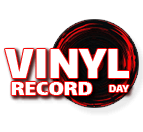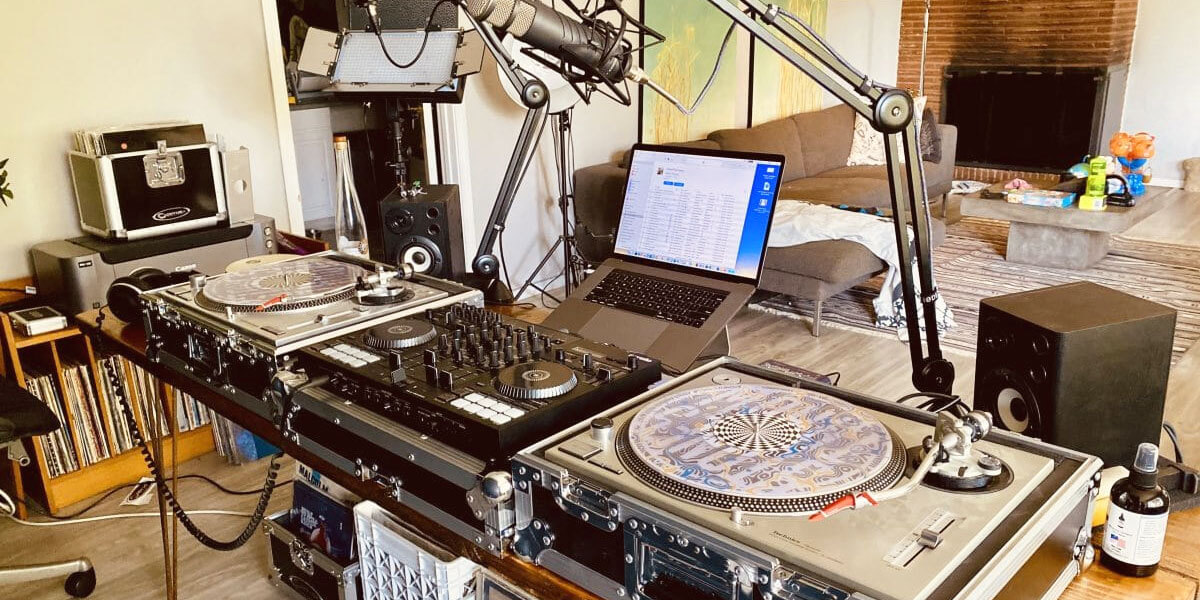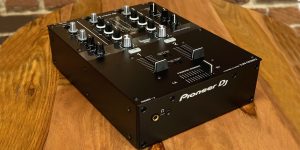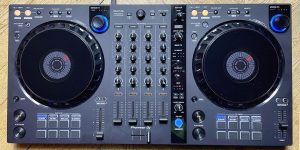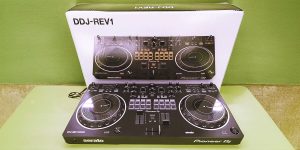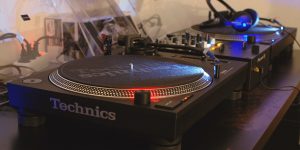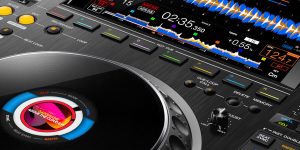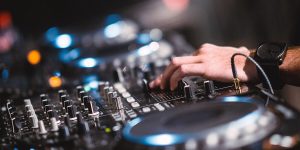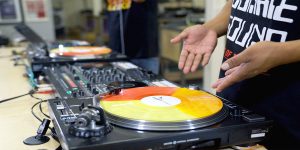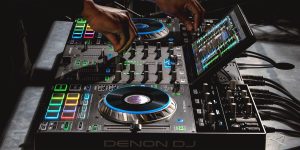Looking to channel your inner Calvin Harris or Carl Cox? With the right DJ set up at home, you can transform your living room, bedroom, or basement into a personal soundstage. Mixing and scratching are no longer exclusive to nightclubs or vast music festivals.
Our homes are our sanctuaries, and for music enthusiasts, they’re also the perfect place to indulge in the art of DJing. This article will guide you through the journey of creating your very own home DJ setup. From selecting the essential components to enhancing your skills, I’ll cover every step of this process. So, it’s time to dive in, and before you know it, you’ll be dropping beats that resonate beyond the walls of your home studio.
Essential home DJ setup components
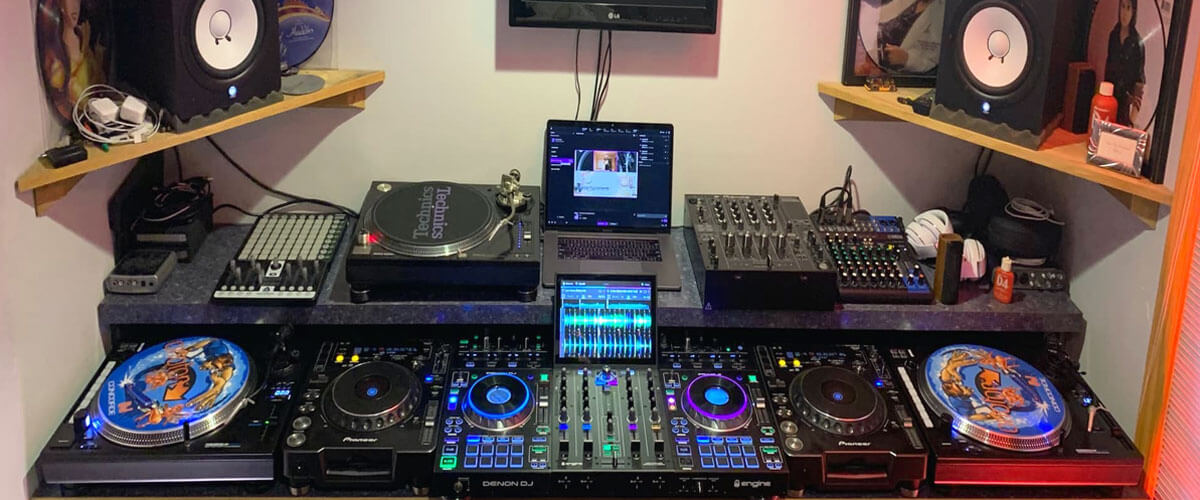
Let’s take a look at the indispensable components of a home DJ setup, highlighting the gear that will transform your space into a pulsating hub of musical creativity.
Professional headphones
Good DJ headphones provide clear, balanced sound, allowing you to monitor your mix accurately. Look for models with proper noise isolation since you’ll want to keep the outside world at bay while fine-tuning your sonic creations.
Comfort is also an important factor. DJing is often a long-haul affair, and the last thing you want is a pair of headphones that feel like a vice on your head after an hour of use. Consider features like adjustable headbands, plush earpads, and the choice between over-ear and on-ear designs. Your DJ journey will become an exhilarating, comfortable sonic adventure with the right cans.
Quality speakers or monitor system
The speakers you choose can make or break your sound. They should deliver clear, accurate audio that faithfully reproduces your mix.
When choosing speakers, consider specifically designed models for studio use – they provide a flat frequency response without coloring the sound and allowing you to hear your mix as it truly is.
However, don’t forget about the size of your room. Large, powerful speakers might overwhelm a small space, while compact ones could leave a larger area sounding sparse. Finding the right balance is key for your audio experience.
Microphone
Let’s discuss another important part of your home DJ studio – the microphone. While not essential for everyone, a good mic can be an invaluable tool for those looking to add a personalized touch to their sets or planning on streaming their mixes online.
Consider a dynamic DJ microphone – it’s durable and can handle high sound pressure levels. Plus, it should offer clear, natural sound reproduction. You might also want a mic with a built-in pop filter to reduce unwanted noise from breath and wind.
Laptop or computer
You’ll need a reliable machine to run your DJ software and store your music library. Modern DJing often involves manipulating digital tracks, so horsepower matters. Look for a computer or laptop with a strong processor, ample memory, and a solid-state drive for speedy access to your tunes. And, of course, the larger the screen, the easier it will be to navigate your software; however, portability might also be a consideration for on-the-go gigs.
Software options
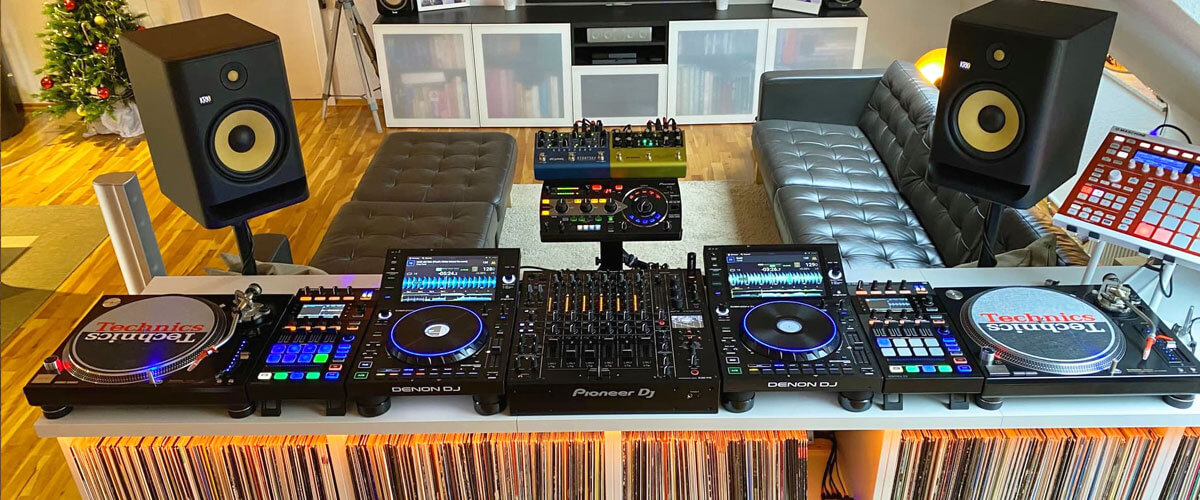
DJ software serves as the digital engine for your mixes, allowing you to seamlessly blend tracks, create loops, add effects, and much more right from your laptop or computer. Here are some of the finest options:
- Serato DJ Pro. Known for its user-friendliness and reliability, Serato DJ Pro offers features like key shifting and beat matching, making it suitable for both beginners and professional DJs.
- Traktor Pro 3. This software by Native Instruments is perfect for DJs who love to experiment. Features like Stem decks and Remix decks provide unique ways to manipulate tracks.
- Rekordbox DJ. Designed by Pioneer DJ, Rekordbox DJ seamlessly integrates with Pioneer’s range of controllers and mixers. It’s a powerful tool, especially for DJs already using Pioneer hardware.
- Virtual DJ. This versatile software not only allows audio mixing but also offers advanced features like video mixing and karaoke functionality. It’s a great choice for those seeking additional perks beyond standard DJing.
Each of these software packages offers unique features, so it’s important to choose one that aligns with your needs, budget, and hardware.
DJ controller setup
Now, it’s time to talk about setting up your DJ controller, the tangible command center of your DJing studio.
Connecting your DJ controller
Your first task is to connect your DJ controller to your computer. Most modern controllers use a USB connection, which makes things pretty straightforward. Connect one end of the USB cable to your controller and the other to your computer. Then, you’ll want to connect your speakers or monitors to the outputs on your controller. These could be RCA, XLR, or TRS outputs, depending on your controller and speakers.
Understanding the basic features
Even though controllers may differ in layout and design, some basic features should be present.
- Jog wheels. These are used for scratching and beatmatching, aligning your tracks for a smooth mix.
- Faders. They slide vertically to control the volume of each channel, helping you transition seamlessly between tracks.
- Crossfader. Located at the bottom of the mixer section, the crossfader allows you to smoothly switch audio output from one deck to another.
- Play, cue, and sync buttons. The ‘play’ and ‘cue’ buttons control track playback. ‘Cue’ sets a temporary start point in your track that you can return to. The ‘sync’ button helps match the tempos of your tracks for easy beatmatching.
- EQ knobs. These control the high (treble), mid, and low (bass) frequencies, helping you shape your sound and manage potential frequency clashes between tracks.
Learning to navigate your controller may seem like a big task initially, but with some exploration and practice, you’ll be fluent in no time.
Creating a suitable environment
Now that we’ve explored the equipment essentials let’s discuss how to shape the ideal environment for your home DJ setup. You’ll want to foster a space that not only bolsters your creativity but also guarantees the finest sound quality.
Choosing the right space
The first step in creating a suitable DJ environment is choosing the right space. It doesn’t have to be vast, but it should be comfortable enough to accommodate your equipment and allow you to move freely. Consider the room’s acoustics too. Spaces with carpeting or heavy drapes can absorb sound and reduce echo, giving you a more accurate perception of your mix.
Soundproofing your space
The next consideration is soundproofing. Whether to prevent disturbing others or to keep outside noise from disrupting your mixing, soundproofing is worth the effort. Thick curtains, carpeting, or specially designed acoustic panels can help insulate your space. Foam bass traps in room corners can help control low-frequency resonances that might muddy your sound. Remember, the goal is to keep the sound in and outside noise out.
Lighting
Finally, let’s not forget about lighting. It’s an often overlooked yet crucial aspect of creating the right atmosphere. Soft, ambient lighting can help enhance your creative vibes while also reducing screen glare. Consider LED strips or color-changing bulbs that allow you to change the color and intensity of the light based on your mood or the vibe you want to set.
Beyond just hardware, curating an inspiring, dedicated space is key to unleashing your creativity and delivering superb sound. Carefully refine each aspect, and you’re on track to establish an exceptional home DJ setup.
DJ mixer and turntable setup
DJ mixer and turntable are your conduits for manipulating sound and crafting your unique mixes.
A DJ mixer acts as the hub of your DJ setup. It’s the gateway through which all your sound sources (turntables, DJ controllers, microphones) connect and interact.
To set up your DJ mixer, you have to connect your turntables or controller to the mixer’s channels using RCA cables. Note that the left deck typically goes into Channel 1 and the right deck into Channel 2. If you’re using a microphone, that will usually plug into a dedicated mic input on the mixer.
Balancing your DJ mixer is crucial for producing a clean and clear sound. Each channel on the mixer will have a gain or trim control that adjusts the input level of your tracks. Start by setting your channel faders and the master output level to their maximum positions. Play your loudest track and adjust the gain until the level meters on the mixer show the signal hitting around the top of the green zone or just into the yellow. This ensures you’re getting a strong signal but not overloading the mixer, which can cause distortion.
The equalizer (EQ) controls on your mixer allow you to shape the sound of each channel. You can tweak the bass, mid, and treble frequencies to your liking or blend tracks seamlessly during transitions.
Mastering your equipment and fine-tuning your mixer are key steps to unlocking your signature sound. Don’t rush it – explore, experiment, and in due time, you’ll be spinning tunes that are a true reflection of your distinctive style.
Sound system setup
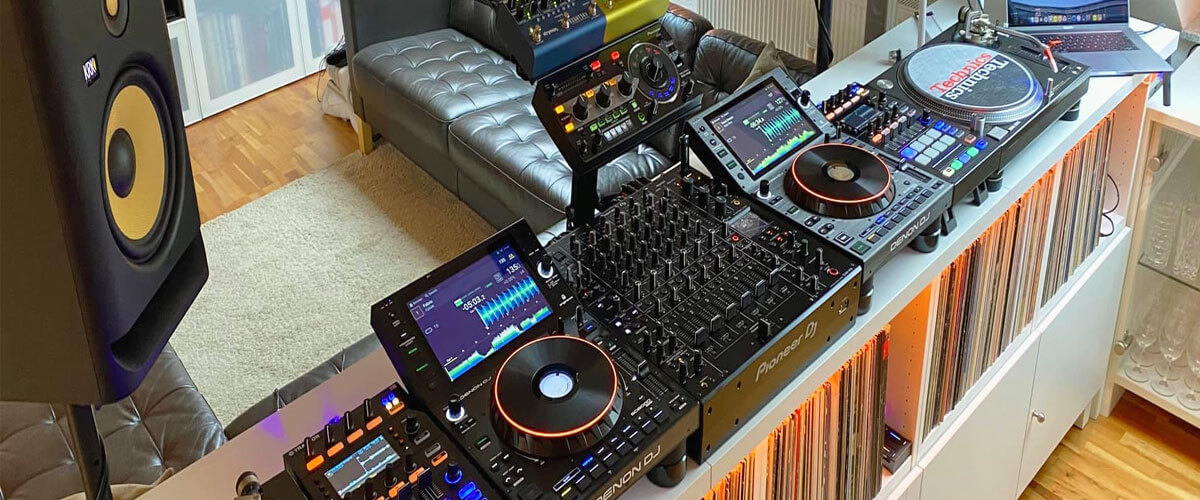
Optimal positioning of speakers, careful placement of subwoofers, and thoughtful sound optimization are crucial factors in crafting a top-notch audio experience.
Speaker positioning
Speaker placement has a significant impact on your sound. Ideally, you want to set them up at ear level and position them to form an equilateral triangle with your usual DJ spot. This ‘sweet spot’ is where the sound from both speakers meets, providing the most accurate stereo image. Also, keep the monitors away from walls and corners to reduce sound reflection and avoid muddying your audio.
Setting up subwoofers
If your equipment includes a subwoofer, proper positioning is important for an optimal low-frequency response. While bass sounds are less directional, situating your subwoofer against a wall or in a corner may cause it to reverberate excessively, leading to overpowering bass. Experiment with various spots to pinpoint the location that delivers a balanced, clear bass sound.
Optimizing sound quality
Once you’ve arranged your speakers and subwoofer, focus on refining your sound. Monitor your sound levels to maintain harmony between the bass, midrange, and treble frequencies. Keep your volume at a comfortable level; while blasting music can be exhilarating, it can result in distorted sound and risk damaging your hearing.
Sound system setup is as much an art as a science, and the effort you put into it will pay off in the quality of your mixes.
Advancing your skills
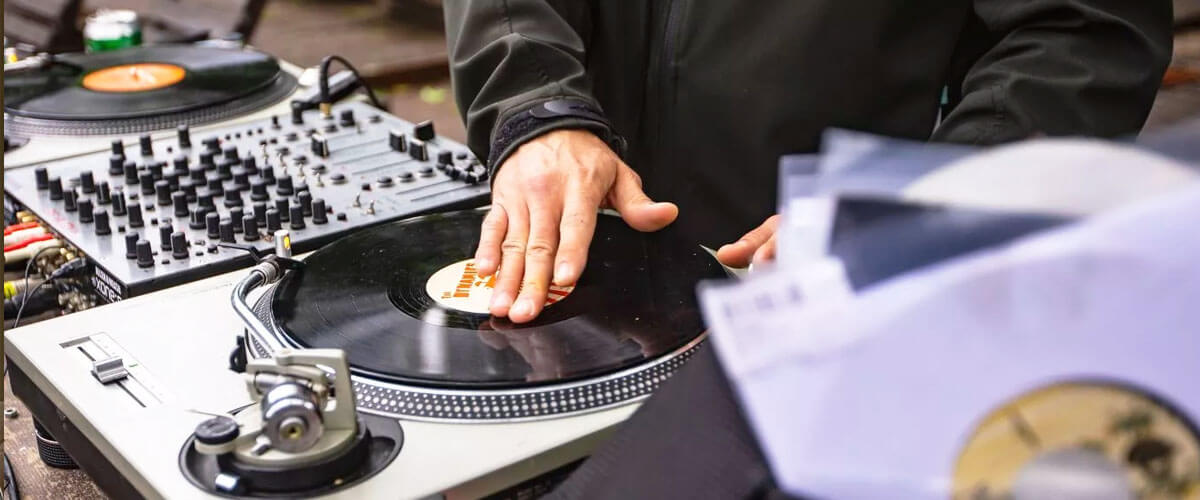
Up next, we’ll shift our focus to honing your skills. Whether you’re working on a DJ setup for beginners or aiming to level up, we’ll dive into valuable practice tips and build a versatile music library.
Practice tips
Stepping up your DJ game is all about regular, mindful practice. Here’s a handful of tips that can spice up your sessions and elevate your skills:
- Keep the rhythm. Regularity matters more than the duration. Even quick practice sessions can do wonders if done consistently.
- Ear training. Sure, modern software can sync beats for you, but there’s a certain satisfaction and reliability in mastering beatmatching by ear. It’s a classic skill that will never let you down.
- Playback and reflect. Recording your mixes isn’t just about sharing them. It’s a powerful tool for self-improvement, letting you critique your own work and spot areas that need a bit of tweaking.
And remember, DJing is like any art – your journey is unique to you. There’s no need to sprint toward an imaginary finish line. Soak up the experience, and in no time, you’ll see your DJ skills blossoming.
Building a music library
A music library is more than just a collection of tunes – it’s a DJ’s toolbox, filled with sonic tools ready to craft unique sets.
- Diversity is essential. Include a variety of genres, moods, and tempos in your library. It lets you respond to different crowd vibes and keep your sets fresh and engaging.
- Quality over quantity. It’s tempting to hoard tracks but remember, every song in your library should serve a purpose. Prioritize high-quality tracks that resonate with your style and audience.
- Stay organized. An organized library can be a real lifesaver during a gig. Sort your tracks by genre, energy level, or any other criteria that make sense to you. Also, consider maintaining playlists for different moods or event types.
- Keep it updated. Music trends evolve, and so should your library. Regularly add new tracks, but don’t forget to revisit old ones—they can bring a nostalgic touch to your sets!.
Building a music library is a continuous process, much like refining your skills. So, keep digging for those hidden gems and curate a collection representing you as a special DJ.
